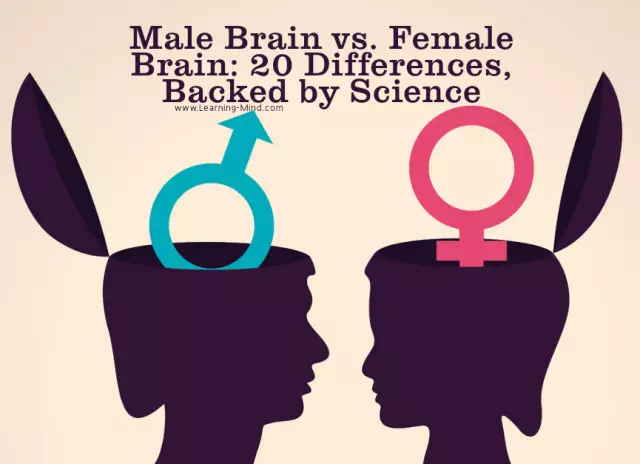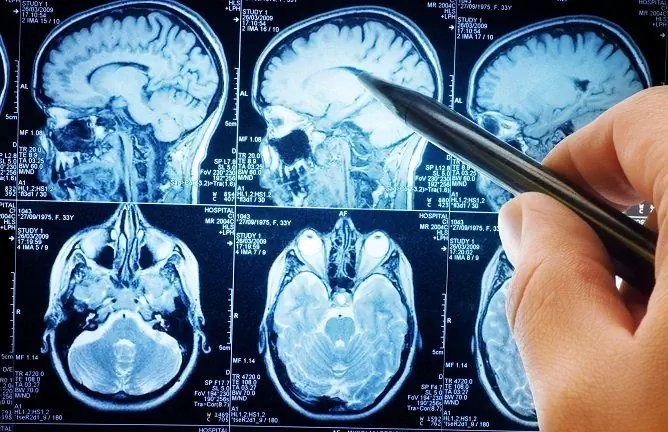- Author Rachel Wainwright [email protected].
- Public 2023-12-15 07:39.
- Last modified 2025-11-02 20:14.
Brain cyst

A cyst is a pathological hollow formation in organs, characterized by the presence of a membrane and fluid that fills the entire cavity.
What is a brain cyst. Types of brain cysts
A brain cyst is a hollow formation in the structures of the brain, filled with cerebrospinal fluid, characterized by different localization. Depending on the type of tissues that form the cysts of the brain, and the localization of the formations themselves, the following types of cysts are distinguished:
- Arachnoid cyst is a cystic formation that has arisen between the layers of the arachnoid (arachnoid) membranes of the brain, filled with cerebrospinal fluid. It is more common in male patients (in children and adolescent patients). If the pressure inside the arachnoid cyst exceeds the intracranial pressure, then in this case the cyst exerts a compressive effect on the cerebral cortex, causing characteristic symptoms. An arachnoid cyst of the brain can be congenital (formed as a result of a violation of embryonic development) and acquired (formed as a result of inflammatory and infectious diseases);
- A colloidal cyst of the brain is a cystic formation that occurs at the stage of embryonic development during the formation of the central nervous system of the fetus. A colloidal cyst may be asymptomatic throughout the patient's life. The main risk that arises with a brain cyst of this type is a violation of the cerebrospinal fluid flow, which leads to negative consequences (hydrocephalus, the formation of cerebral hernias, death);
- Dermoid / epidermoid cyst of the brain is a formation that appears in the first days of fetal formation, which explains the detection of hair fibers and fat in the cyst tissues. This type of brain cyst is characterized by rapid growth and must be surgically removed in order to avoid the development of severe consequences;
- Pineal cyst of the brain is a small volume formation in the pineal gland (pineal gland). With an untimely diagnosis of the pineal cyst of the brain, the consequences can be a violation of metabolic processes, vision, coordination, encephalitis, hydrocephalus.
Colloidal, dermoid (epidermoid) and pineal types of brain cysts belong to cerebral (intracerebral) formations.
Cyst of the brain: symptoms of education
When a cyst of the brain is detected, symptoms can be both general and specific. With a cyst of the brain, the symptoms are determined by the main factor that caused the formation of the cavity. A number of symptoms, however, will depend on the dynamics of growth and development of the cystic formation and its effect on brain structures.
The main symptoms of a brain cyst include:
- A feeling of throbbing in the head, a feeling of fullness or pressure in the head;
- Headache, frequent causeless dizziness;
- Impaired coordination of movements;
- Hearing impairment;
- Tinnitus while preserving hearing;
- Visual impairment (double vision of objects, blurred images, spots);
- Hallucinations;
- Violation of skin sensitivity, development of paralysis, paresis of the limbs;
- Epileptic seizures;
- Tremor of hands, feet;
- Episodic loss of consciousness;
- Sleep disturbance;
- Nausea, vomiting (more common in children).
It should be noted that most often the development of a brain cyst does not have vivid symptoms, the cyst itself is detected during regular examination of the patient.
Cyst of the brain: the reasons for the development of education
When a brain cyst is detected, the causes of its development are the main purpose of diagnosis to determine the tactics of treatment. When diagnosing a brain cyst, the following factors can be the reasons for its formation:
- Intrauterine developmental disorders, in which a brain cyst is a congenital anomaly;
- Degenerative and dystrophic disorders in the brain, in which the replacement of brain tissue with cystic formation occurs;
- Brain trauma (including birth);
- Acute disorders of cerebral circulation.
Brain cyst in newborns: types of cysts, causes of development

A neonatal cyst is a fluid-filled hollow mass that replaces a lost part of the brain. Such formations can be single and multiple, have different localization.
There are three main types of brain cysts in newborns:
- Choroid plexus cysts are a variant of the norm, arise at a certain stage of embryonic development, regress until they disappear completely. Such cysts do not pose a danger to the normal brain activity of the child. Much more dangerous are vascular plexus cysts that have arisen after the birth of a child. Such formations are a consequence of inflammation and infections suffered by a woman during pregnancy. One factor is the herpes virus;
- The subependymal cyst of the brain of newborns occurs due to insufficient blood circulation in the brain and insufficient oxygen supply. This is a more serious violation. The dynamics of the development of such education requires constant monitoring;
- Arachnoid cyst of the brain in newborns has the same etiology as in adults. Education occurs on the membranes of the brain, can significantly increase in size, putting pressure on the surrounding structures of the brain, which may result in progressive seizures, an increase in neurological symptoms, and a deterioration in the general condition of the child.
Brain cyst: treatment, prognosis
When diagnosing a brain cyst, treatment is selected based on the root cause of the formation. Nondynamic brain cysts do not require treatment. If a dynamic cyst of the brain is found, treatment can be:
- Conservative - drug treatment, the action of which is aimed at eliminating the cause of cyst formation: drugs that absorb adhesions, restore blood supply, antibacterial, antiviral, immunomodulatory drugs for infections and autoimmune diseases;
- Radical - surgical removal of the brain cyst. The main methods are endoscopy, craniotomy, cyst shunting (the risk of infection is increased with long-term presence of the shunt in the cranial cavity).
Cyst of the brain: consequences of the disease
In case of untimely diagnosis and treatment of any type of brain cyst, the consequences can be of a different nature:
- Impaired coordination, motor function;
- Hearing and vision impairment;
- Hydrocephalus (dropsy of the brain) is an excessive accumulation of cerebrospinal fluid in the ventricular system of the brain, which is a consequence of its difficult movement from the place of secretion to the place of absorption;
- Encephalitis is a class of diseases characterized by inflammatory processes of the brain of various localization and etiology;
- Sudden death of the patient.
YouTube video related to the article:
The information is generalized and provided for informational purposes only. At the first sign of illness, see your doctor. Self-medication is hazardous to health!






